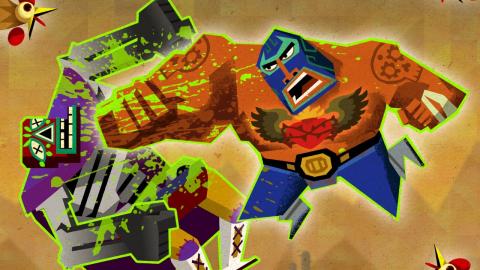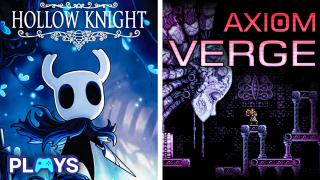Top 10 2D Metroidvania Games

These are the games that make backtracking fun. Join http://www.WatchMojo.com as we countdown our picks for the Top 10 2D Metroidvania Games.
Metroidvania games, named after the Metroid and Castlevania series, are defined as nonlinear action-adventure games with large, interconnected maps where items and abilities gained over the course of playing provide access to previously locked areas through backtracking.
Special Thanks to our users "Alvaro Salvagno" "ABOhiccups" "Dan Rogers"
Top 10 2D Metroidvania Games
The 10 BEST Metroidvania Games Ever
These are the games that make backtracking fun. Join http://www.WatchMojo.com as we countdown our picks for the Top 10 2D Metroidvania Games. Metroidvania games, named after the Metroid and Castlevania series, are defined as nonlinear action-adventure games with large, interconnected maps where items and abilities gained over the course of playing provide access to previously locked areas through backtracking. Though there have been 3D games that can be considered Metroidvania, we’re only looking at 2D games here. Our one entry per franchise rule also applies.
#10: “Aliens: Infestation” (2011)
Aliens: Colonial Marines: Everything You Should Know
While the Aliens franchise hasn’t had the best reputation for its games, this entry for the Nintendo DS certainly stands out. You guide a small team of marines around the U.S.S. Sulaco as they investigate the causes of the Xenomorph menace. What separates Infestation from the other games on this list is the use of permadeath. If any of your marines die, they’re gone for good, and it’s game over if they all go down. This added risk is a perfect fit for Aliens’ tense aesthetic, capturing the tension of the franchise in a most unlikely package.
#9: “Muramasa: The Demon Blade” (2009)
Though their catalogue is pretty thin compared to other developers, Vanillaware has a reputation for creating gorgeous games, and Muramasa is no exception. Set in a world inspired by Japanese mythology, the game follows Kisuke and Momohime, powerful youths each with their own story. Muramasa’s somewhat simple world structure is more than made up for by its deep and satisfying combat system. With two blade types, multiple chainable combos and a bunch of enemies to slice up, you’ll never be short of action.
#8: “Ori and the Blind Forest” (2015)
Best Horror Game of 2018: The Forest
Next up is this stunning indie effort. The game follows Ori, a guardian spirit, as he attempts to restore his forest home after a disastrous event withers it, taking the life of his adoptive caretaker, Naru. Pulling off the usual Metroidvania mechanics beautifully, Ori also introduces “soul links”. These are freely placeable checkpoints affording players a way to ease the more difficult challenges. However, the items required to place them come in short supply so some strategy is needed. Solid gameplay and strong storytelling make this an easy pick for our list.
#7: “Shantae and the Pirate’s Curse” (2014)
Next is the third installment in this series about a half-genie hero who, now after losing her genie powers, teams up with her rival, Risky Boots, to stop the return of the evil Pirate Master. Without her powers, Shantae learns to use a set of pirate gear, including a pistol, scimitar and even a hat, each with its own special utilities. She’ll need them when exploring the expansive world, said to be twice as large as the game’s predecessor.
#6: “La-Mulana” (2005)
Top 20 Best Indie Games of the Century (So Far)
If Indiana Jones were a Metroidvania game, and it’d look something like this. Whip cracking hero. Ancient temples. Hell, it calls itself an “Archaeological Ruin Exploration Action Game”. La-Mulana is known for its relentless difficulty and nods to its inspiration, the MSX home computer. Among the regular weapons and equipment, special items can be found or purchased as ROM cartridges to be mixed and matched in your character’s MSX laptop for various effects. There’s actually 2 versions of this game, the original 2005 which was made to look like an old MSX game that was only released in Japan. And a remake released in 2012 with modern graphics and audio.
#5: “Shadow Complex” (2009)
Shadow of the Tomb Raider - Review
While on a hiking trip, our protagonist Jason discovers a massive underground complex housing state-of-the-art technology and the small army guarding it. Luckily, the technological goodies found throughout take Jason from everyman to supersoldier. Soon enough, he’s running and blasting through any-and-everything in a cybersuit, stacked with a full range of upgrades. Shadow Complex’s controls are smooth and responsive with dual-stick shooting and cover mechanics, making it a perfect example of Metroidvania for the modern era.
#4: “Cave Story” (2010)
In the midst of exploring a cave he mysteriously wakes up in, an amnesiac boy soon uncovers a man’s evil plot to force the cave’s bunny-like inhabitants into rabid savagery and dominate the world. Naturally, he decides to stop him… because what else is he gonna do? Cave Story is one of the few Metroidvanias that weighs more on the Metroid side. Controls are easy to use. There are plenty of upgrades to find and ten weapons to collect, all upgradable and some strange. You’ll need them to combat what dangers await within.
#3: “Guacamelee!” (2013)
Sometimes an evil skeleton attacks your village. Sometimes you die trying to save the president’s daughter from said skeleton. Luckily, sometimes you’re given a mask in the afterlife that transforms you into a mighty luchador with awesome, otherworldly powers. Guacamelee is held in highest regard among critics and players. The combat system allows you to chain moves together, juggle and throw enemies without missing a beat. Exploring the world hinges on switching between the realms of the living and the dead, giving you two gorgeous versions of every environment. Plus, it’s one of the only solid titles in the genre to offer coop play!
#2: “Super Metroid” (1994)
10 Hidden Secrets In Super Mario Games
For our runner up, we have the game that started it all. Super Metroid established the now well-known formula, and besides being one of the best of its genre, it’s a masterclass in games on the whole. Great graphics, timeless gameplay, engrossing atmosphere and sound design. Among the concepts it introduced to the series and genre are the ability to hold aim while moving, switch certain weapons and abilities on and off, and combine different weapon beams for special attacks. Super Metroid will always be celebrated, but it’s falls just short of number one. Before we get to our rather obvious top picks, here are some honorable mentions. “Axiom Verge” “VVVVVV” “Strider” “Dust: An Elysian Tail” “Insanely Twisted Shadow Planet”
#1: “Castlevania: Symphony of the Night” (1997)
Castlevania: Games VS Series - What Changed?
Super Metroid may have established the formula, but Symphony of the Night perfected it. It has the perfect balance of playability and challenge, freedom and guidance. Allucard might be a vampire, but he certainly doesn’t suck in combat, with a huge variety of weapons and spells at his disposal. The map encourages exploration and experimentation, and has a clear visual design that allows players to know where they are at any time. Designer Koji Igarashi claims that he was actually trying to capture the feel of the top-down Zelda games, but its side-scrolling gameplay drew comparison to Metroid. We’re certainly not complaining. Do you agree with our list? Which Metroidvanias did we miss? For more adventurous top tens published daily, be sure to subscribe to WatchMojo.com


 0
0
 0
0
 flagged
flagged







